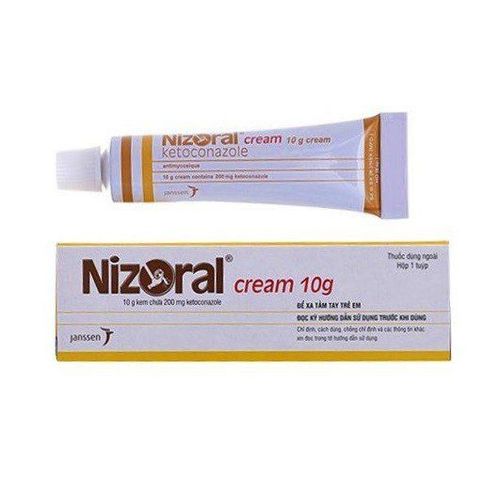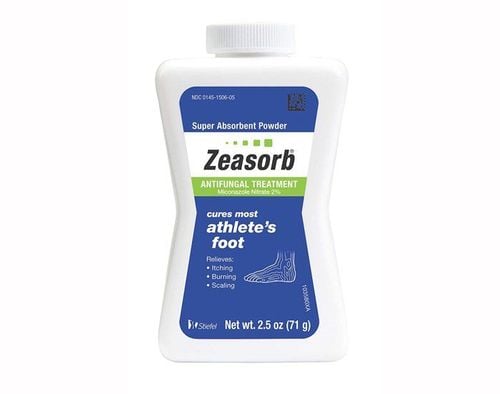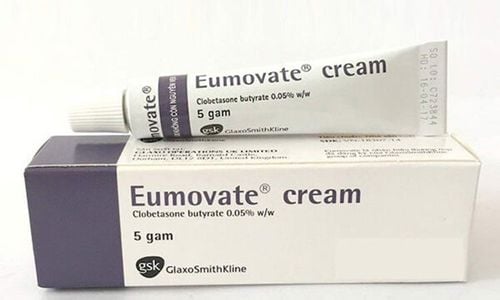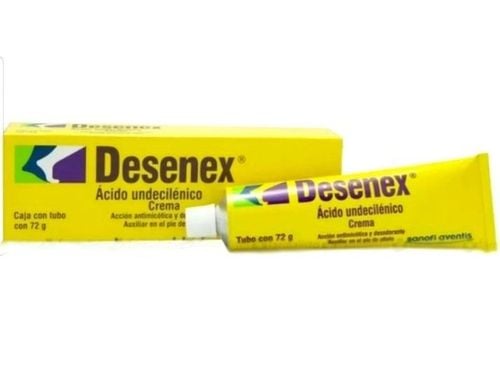This is an automatically translated article.
Terfuzol topical treatment for skin diseases such as: atopic dermatitis, contact dermatitis, seborrheic dermatitis, neurodermatitis. Terfuzol treats psoriasis, lichen planus, insect bites, fungus, tinea versicolor,... Let's learn the information in the following article to understand more about the uses of Terfuzol and how to use it.
1. What is Terfuzol?
Terfuzol is a topical cream belonging to the group of dermatological drugs with active ingredients including Triamcinolone Acetonid, Nystatin, Neomycin Sulfate, Clotrimazol, which is prepared in the form of a cream tube of 10 grams. This product belongs to Gia Nguyen Pharmaceutical Company.As a synthetic topical cream, each ingredient in the drug has its own effect:
Triamcinolone: is a synthetic glucocorticoid with a fluorine component, known for its anti-allergic and anti-inflammatory effects. Topical triamcinolone is used to help reduce redness, itching, swelling, or other discomfort caused by skin conditions. Triamcinolone is a corticosteroid (cortisone-like drug or steroid). Neomycin: is an aminoglycoside antibiotic with a spectrum of action and mechanism similar to gentamicin sulfate. The bacteria sensitive to neomycin such as: Escherichia coli, Klebsiella, Haemophilus influenzae, Staphylococcus aureus, Enterobacter types, Neisseria types.
Nystatin is an antibiotic that is both fungicidal and antifungal in vitro against a wide range of yeasts and yeast-like fungi, including Candida albicans, C. parapsilosis, C. Tropicalis, C. guilliermondii, C. . pseudotropicalis, C. krusei, Torulopsis glabrata, Trichophyton rubrum, T. mentagrophytes.
Clotrimazole is a broad-spectrum antifungal agent that inhibits the growth of pathogenic yeasts by altering the permeability of cell membranes, causing loss of essential intracellular substances leading to the destruction of fungal cells. The action of clotrimazole is antifungal when administered at concentrations up to 20 mcg/mL and in vitro can be fungicidal against Candida albicans and other species of the genus Candida but at higher concentrations.
Absorption of topical Terfuzol
Triamcinolone: absorbed when used externally, especially when the bandage is closed or the skin is damaged, the drug can be well absorbed, causing systemic effects Neomycin: the drug can be absorbed after It is applied to damaged skin, and is rapidly excreted by the kidneys in an active form. Nystatin: not absorbed through the skin or mucous membranes when used topically Clotrimazol: topical application clotrimazol very little absorption. Six hours after application of radioactive clotrimazol cream and 1% solution on intact skin and on acutely inflamed skin, concentrations of clotrimazole varied from 100 micrograms/cm3 in the stratum corneum to 0.5-1 micrograms/cm3 in the stratum corneum. and 0.1 microgram/cm3 in the subcutaneous tissue layer. Distribution: Triamcinolone is distributed into all tissues in the body (muscles, liver, skin, intestines, kidneys...). The drug crosses the placental barrier and is secreted into breast milk in small amounts. The drug is mainly bound to plasma albumin.
Metabolism: Triamcinolone is metabolized mainly in the liver, partly in the kidneys.
Elimination: The drug is excreted in the urine, the half-life of the drug is 2-5 hours.
2. Uses of the drug terfuzole
2.1. Indications of terfuzol: Local treatment of corticosteroid-responsive skin diseases complicated by secondary infections caused by fungi and bacteria such as: atopic dermatitis, contact dermatitis, seborrheic dermatitis, neurodermatitis Menorrhagia, acute and chronic eczema, psoriasis, lichen planus, insect bites. Topical treatment of ringworm with secondary bacterial infection and/or with inflammatory symptoms such as tinea pedis, inguinal fungus, interstitial fungus, ringworm, ringworm, external vaginal candidiasis, foreskin .
2.2. Contraindications of topical terfuzol Do not use the drug when having viral skin diseases, skin tuberculosis, rosacea or hypersensitivity to any of the ingredients of the drug or for children under 2 years of age.
2.3. Side effects of terfuzol The drug is used topically, so the following side effects often occur:
Itching, irritation, burning sensation on the skin, dry skin, acne-like rash, folliculitis, hirsutism , hypopigmentation, blistering, secondary infection, skin rash, skin atrophy, millet skin disease. Use of topical Clotrimazol has rare side effects including: irritation, which may cause minor burns, allergic contact dermatitis, burning pain on the skin or in the vagina. Topical use of Nystatin but covered with a bandage has very rare side effects such as: burning, itching, irritation, erythema, blistering, skin irritation. Use of topical Neomycin: may experience hypersensitivity reactions such as itching, dermatitis, drug fever and more severe anaphylaxis. Note: Inform your doctor as soon as you experience any unwanted effects when using the drug.
2.4. Overdosage and treatment When you use topical corticosteroids excessively or for a long time, there will be drugs that can be absorbed into the body and cause some systemic effects such as inhibition of renal function. underactive pituitary and adrenal glands leading to secondary adrenal insufficiency.
Especially when Neomycin is used too much and for a long time on the skin, it can be absorbed and cause nephrotoxicity in users.
Treatment: Apply only clinically appropriate symptomatic therapy. Symptoms of adrenal hypersecretion are usually reversible. If necessary, treat electrolyte imbalances. In case of chronic poisoning, the drug should be discontinued gradually. Kidney damage can be reversed after stopping neomycin for a while and you should see your doctor for specific treatment in case of nephrotoxicity.
2.5. Precautions before taking terfuzol Discontinue use if irritation, hypersensitivity, excessive dryness or other reactions occur. Caution when using drugs for pregnant women: Drugs used during pregnancy can cause adverse effects (miscarriage, teratogenicity, fetal malformations...) to any stage of development of the fetus. pregnancy, especially the first trimester. Therefore, it is best not to use the drug for pregnant women. In the case of mandatory use, it is necessary to consult carefully with your doctor, pharmacist before making a decision. Use with caution when giving the drug to a nursing woman: The drug can be passed to the baby through breastfeeding. It is best not to or limit the use of the drug during breastfeeding. Many drugs have not yet fully determined the effects of the drug during this period, so mothers need to carefully read the instructions for use and consult with doctors and pharmacists before deciding to use the drug. Use caution when using drugs for a long time, treating large areas of skin, covered with bandages and used to treat children. Use caution when using the drug to treat dermatitis caused by stasis or poor blood circulation. Avoid letting the medicine come into contact with your eyes
3. How to use terfuzol effectively
Before applying, it is necessary to carefully clean the infected skin and clean hands. Take an appropriate amount of the drug, apply it gently to absorb evenly.
Use the drug according to the recommended dose or as specified by a qualified doctor/pharmacist. Recommended to apply 2-3 times per day.
Apply a thin layer of Terfuzol to the affected area and rub in gently and thoroughly.
The use of any type of air-tight cover on Terfuzol may increase the absorption of the drug and the possibility of irritation and other side effects. Therefore, do not bandage, wrap, or apply any other gas-tight or bandage material (for example, kitchen plastic wrap) over Terfuzol unless directed to do so by your doctor. Also, wear loose-fitting clothing when using Terfuzol on the groin area. When using Terfuzol on a baby's diaper area, avoid tight diapers and tight pants.
To help clear up your infection completely, keep using Terfuzol for the full time of treatment, even if your symptoms have disappeared. Do not miss any dose. However, do not use Terfuzol more often or for longer than directed by your doctor. Doing so may increase absorption through your skin and the possibility of side effects. In addition, excessive use, especially on thin areas of skin (eg face, armpits, groin) can lead to thinning of the skin and stretch marks.
Please dial HOTLINE for more information or register for an appointment HERE. Download MyVinmec app to make appointments faster and to manage your bookings easily.













